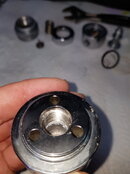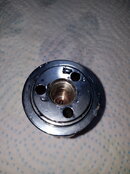happy-diver
Skindiver Just feelin it
- Messages
- 5,326
- Reaction score
- 4,790
- # of dives
- 2500 - 4999
5% or 10% undiluted, 2 mins in microwave then ultrasound or not and keep an eye on your stuff.
Five minutes...So soaked or ten

Phosphoric undiluted cold, five or ten minutes for big stuff eyelets double hose cans etc... Brush on

One more phosphorisation to go
The key is to use nylon or plastic tools to chip or chisel off stubborn lumps without dragging
the removed hard verdigris stuff across your chrome, scratching it like all the dumb arses do
Had to save the Draeger seal transfer ha ha ha ha ha!!!!
Five minutes...So soaked or ten
Phosphoric undiluted cold, five or ten minutes for big stuff eyelets double hose cans etc... Brush on
One more phosphorisation to go
The key is to use nylon or plastic tools to chip or chisel off stubborn lumps without dragging
the removed hard verdigris stuff across your chrome, scratching it like all the dumb arses do
Had to save the Draeger seal transfer ha ha ha ha ha!!!!






